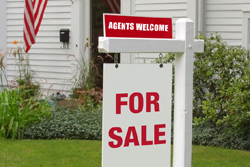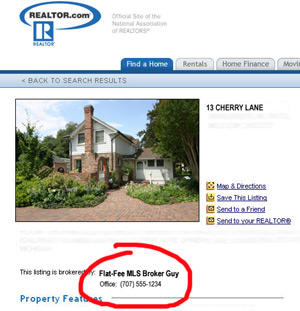Real
estate training courses usually talk a lot about marketing.
Unfortunately, the focus is usually on how agents should market
themselves to prospective clients, not on how agents should market their clients' property.
The
reason is that a real
estate listing contract, once signed, doesn't give an agent much
incentive to spend money marketing a client's property.
Paying for professional staging, color brochures, virtual tours,
professional photographs, and classified ads might raise the sales
price of a house by tens of thousands of dollars, but the listing
agent will often get only about 1.5% of that increase (assuming the
total commission is 6%, and that it's split between the listing
agent and buyer's agent, and split again between these agents and
their respective brokers). If an aggressive marketing campaign
were to push up the price of a house by $20,000, a listing agent
might
get only $300.
And
that's only if the house sells. If the listing contract
expires before then, and if it isn't renewed, the agent will get
nothing. Spending money to market a client's property,
in other words, is a high-risk, low-return investment. No
wonder agents scrimp.
As
a FSBO seller, though, each dollar you spend on marketing offers a
much more generous return. Splurging on marketing also helps
you overcome the perception some people have that FSBO
sellers aren't serious about selling their homes. One of your
marketing goals is to persuade prospective buyers that you're
committed to selling your house and that it's worthwhile for them
to check it out and prepare an offer.
Here's
to make sure your property gets noticed by prospective buyers:
Signs
Many
flat-fee brokers or national FSBO website chains will ship
corrugated plastic yard signs as part of their packages. I
recommend that you opt instead for a sign that hangs from a big
wooden yardarm (also known as an L-post).
You'll
also want sign riders--narrow signs that give people
special information (e.g., "Swimming pool," "Home
warranty," "Guest house," "Brokers
welcome," "Open house Sunday 1-4").
|
Unethical
agents will sometimes steer their clients towards their own
listings. This is a problem that affects all sellers,
not just those selling "for sale by owner." To keep
these agents honest, post directional signs so that they can
be seen if an agent tries to take a circuitous route to
avoid your home. |
 |
You'll also need open house signs. I like to use four A-frame (or A-board) Open House signs on nearby corners and one in front
of the house. These signs should be double-sided and have
arrows pointing towards your house. If you like, add your
address to the sign using pre-cut vinyl numbers and letters.
Lightweight A-frames can blow down. If you live in a windy area, get heavy wooden or
metal ones.
Home
improvement and office supply stores often sell small plastic Open House signs on H-stakes. These work well if there
are nearby grassy public areas (parks, schools, and so forth) where you can
briefly put the signs for the duration of your open house. Don't put these signs in a neighbor's
lawn without first getting permission.
Local
FSBO website businesses will sometimes rent signs
as part of their listing packages. If there are no local FSBO
businesses in your area, try calling local sign businesses or go to
a home improvement store.
 |
If
you're cooperating with buyers' agents, it's a good idea to
put up a sign rider that reads "Agents welcome" or
"Brokers welcome" or "MLS listed."
Agents sometimes find FSBO homes while driving around with
clients. The sign will encourage them to stop and look
at your flyers. |
Advertising
I
recommend you
market
your home to two different groups: (1) traditional buyers who work with
buyers’ agents, and (2) nontraditional buyers who want to eliminate
the middleman and deal directly with sellers.
The best way to reach
traditional buyers is to list your home on the Multiple Listing
Service (MLS). (See below for more details.) But the MLS
isn’t a good way to reach nontraditional buyers. MLS rules won’t
allow listings to be identified as FSBOs, nor will they allow the
seller’s contact information to be displayed to the public.
Fortunately, there are
several online resources where nontraditional buyers often use to find FSBO
properties. None of these resources is the dominant player yet, so
it’s a good idea to list your home on several of them.
|
Careful! Some FSBO
directories or directory-posting services are
phonies--set up by real estate agents and mortgage
brokers to grab leads. Their goals vary. Some want to
intercept buyers so they can capture the buyer’s agent’s
commission. Some want to redirect callers to other
listings. Others want to pre-qualify buyers so they can
later sell them overpriced loans.
Here’s how
to avoid the phonies: Only list on FSBO directories that
display YOUR contact information.
You should
also be wary of companies that have buyers dial a
toll-free number followed by an extension to get in
touch with you. I tested one of these services and
wasn’t able to get through to the seller. Instead, the
broker who ran the service captured my cell phone number
and called me back. His goal may have been to get a
commission by intercepting buyers. |
Here’s a list of the
two most popular national FSBO directories. Both are free, and both
allow you to post your own contact information. We recommend that
you post ads on both of them.
1.
Zillow.com. You’ll likely
disagree with Zillow’s “Zestimate” (appraisal) of your property’s
value, but don’t worry about it. Zestimates are notoriously
unreliable.
2.
Craigslist.org. It’s poorly
organized and you have to repost your ad each week, but many buyers
look for FSBO properties there. So many, in fact, that many real
estate agents try to work “FSBO” into ads for traditional listings
(e.g., “This property is NOT a FSBO”) so that they’ll show up in
more search results.
In
addition, there are lots of local FSBO websites
that allow you to create a special webpage devoted exclusively to
your property. This is a very cost-effective way to give
buyers a lot of information about your property. I operate
several FSBO websites in Northern California, including
FSBOSonoma.com,
FSBOSolano.com,
FSBONapa.com,
FSBOAlameda.com,
FSBOContraCosta.com, FSBOSac.com,
FSBOSanMateo.com, and
FSBOSantaClara.com
Postlets.com
will let you post information for free on these online classified ad
services: Craigslist.org, backpage.com,
livedeal.com, base.google.com,
oodle.com, trulia.com,
and propsmart.com.
FSBO directories
are a good place to advertise any price breaks you’re willing to
give buyers who aren’t working with buyers’ agents. For example, if
you’re offering a 2.5% commission on a $600,000 house, you might add
this line to your ads: “Buyers without agents take $15,000 off.”
Don’t, however, put
this line on your flyers, signs, or anywhere a traditional buyer who
is visiting your home with an agent can find it. If you do, buyers’
agents will be reluctant to show your home to their clients.
Finally, always
give your property address when you post an ad--even if it’s
occupied by tenants. Experienced buyers will want to research your
property online and drive by it before they call you. Concealing the
property address creates an obstacle for buyers and discourages them
for seeing your property.
Classified ads
I
think it only makes sense to
run newspaper ads in a hot market. It's simply too expensive
to run these ads month after month.
If you do run a classified ad, it
should contain at least the following information:
-
Price
-
Town
or property address
-
Number
of bedrooms
-
"by
owner"
-
Your
phone number
-
One
or two key selling points
-
The
address of a webpage devoted to the property, if you've set one
up.
Here's
an example:
| Lovingly
restored 3 bedroom Craftsman home with a large garage in West
Petaluma, by owner. $450,000. 555-1234. Find out
more at fsbosonoma.com/1329 |
I
think it's most cost-effective to run classified ads just on Fridays, Saturdays, and
Sundays.
Many
newspapers also have a special boxed section in their real estate
ads for open houses.
Here's an example:
| 29
Elm Street, West Petaluma. Open Sunday 1-4. Lovingly
restored 3 bedroom Craftsman home with a large garage, by
owner. $450,000. 555-1234. Find out more at
fsbosonoma.com/1329 |
Don't waste your money on an open house ad if you expect there to be
other open houses nearby. Just put your signs near the
others.
Fair
Housing Laws
Make
sure that your ads don't break Fair Housing Laws, which prohibit you
from discriminating against buyers based on race, color, national
origin, religion, sex, familial status, and handicap. Avoid,
for example, saying things like "Nice Hispanic
neighborhood," or "A great home for a young couple,"
or "Good Christian home." A good rule of thumb is to
describe just the property, not the sort of person you think might
want to live there. Click
here for a pdf-formatted set of advertising guidelines put out
by HUD in 1995.
MLS
listings
Listing your property
on the Multiple Listing Service (MLS) gets you on
Realtor.com, a national website
that gets over 6 million visitors per month, and assures buyers’
agents that you will “cooperate” (pay them a commission) if they
bring you a buyer who closes escrow.
In the past, you had to
list your property with a full-service listing agent in order to get
on the MLS, but no more. It’s now possible to get an MLS listing for
a low flat fee. To find a flat-fee MLS broker, look in my resources
section or type "MLS flat-fee
broker" plus your state (e.g., "California") as search terms on
an Internet browser. You should find one who will list your property for
about $200 to $400.
Here are the terms you
should insist on from your flat-fee broker:
-
An Open Listing or an Exclusive Agency Listing with a
cancellation clause
Both of these
contracts allow you to find a buyer on your own without paying a
commission. You can revoke an Open Listing Agreement at any
time. Adding a cancellation clause to an Exclusive Agency
Listing also allows you to get out of it whenever you want.
Don’t sign a listing agreement unless it’s a standard contract.
-
A promise to
forward buyer inquiries to you
The Realtor
Associations who manage the various MLSs usually won’t allow
sellers’ names and phone numbers to be displayed on Realtor.com
or other public websites. Buyers are only allowed to see the
flat-fee broker’s contact information. Some flat-fee brokers
take advantage of this--when they get inquiries, their goal is
to capture the buyer’s agent’s commission for themselves. Choose
a flat-fee broker who will give your phone number to buyers who
call about your property. This gives the buyer the option of
buying your home without a buyer’s agent if they wish.
- Posting on the
proper MLS
Make sure your
flat-fee broker promises to put your listing on the appropriate
MLS for your county or region. If a broker lists you on an
out-of-area MLS, you’ll get very few responses from local
buyers’ agents.
- The ability to
rent a SUPRA electronic lockbox
Licensed agents
have special keys that allow them to open these lockboxes to get
keys to homes that are on the market. Many flat-fee brokers
don’t carry these lockboxes. If you list with them, you won’t be
able to rent an electronic lockbox, since MLS rules often
dictate that you can only rent a lockbox from the broker who
lists your property.
- Assurance that
your listing will appear on secondary MLS real estate websites
Examples
include Realtor.com, GreatHomes.org, BayEast.org, and EBRDI.com.
Getting on these websites increases your home’s exposure.
- The ability to
make changes to your listing
Flat-fee
brokers usually allow this, but some charge a fee for each
change. You should be able to request up to five changes without
paying a fee.
- Willingness to
post multiple photos
Make sure your
MLS broker is willing to post multiple photos on Realtor.com and secondary websites.
- Willingness to
verify information and offer advice
A good broker will start
the listing by accessing tax records, then interview you about
the property. This gives the broker an opportunity to warn you
if, say, your estimate of the square footage is off or you’re
making a risky claim about your home (e.g., “quiet, crime-free
neighborhood”).
Before
signing up, ask the broker how long it will take to get your
listing. It should take one or two days at most. A
friend of mine had to wait several weeks before her flat-fee
broker put her listing on the MLS.
Some
tips:
- You
can only get a listing if you're cooperating with buyers'
agents. Though you needn't pay the standard 2.5-3% commission,
I recommend you do so. If you specify a low commission,
the agent may find ways to sabotage the deal.
- Let
the MLS Broker know immediately if you've accepted an offer or
if you've taken your house off the market, so the broker can
change the status of your listing. To
ensure that its listings are up to date, MLS systems
often impose stiff fines on brokers who don't immediately
report changes.
 |
Flat-fee
brokers must use their own names and phone numbers as
contacts on Realtor.com, and they can't write anything in
the Remarks section that will let buyers know that the
listing is a FSBO. The only way for buyers to get in touch
with you directly is if they drive to your address and pick
up a flyer. |
 |
If
you later decide to list with a full-service real estate
agent, you'll need to cancel your contract with the flat fee
MLS broker. |
Flyers
Here
are some tips for creating and distributing flyers:
- Don't
put too much information on your flyer. I prefer a flyer that's printed on
just one side of a sheet of
white paper.
- Be
sure to put your phone number and fax number on the flyer.
Buyers often send offers by fax.
- Some people put black and white flyers in the brochure
box outside and hand out color flyers to people who come inside.
I don't recommend this. Use color flyers--they do a much
better job of selling a home.
- Keep
the brochure box filled with flyers at all times. As a
buyer, I often drive through neighborhoods looking for houses
for sale. If I don't have a flyer for a house, it
sometimes slips my mind.
- Include
driving directions to your house in the flyer.
- If
you're cooperating with buyers' agents, leave lots of color copies of your
flyer at nearby real estate offices.
FSBO
websites often allow you to create flyers using the information you
used to create a web page for your home. Otherwise, you can
create good flyers using Microsoft Publisher or another similar
program.
 |
Just
as peacocks display their vigor with elaborate plumage,
you'll want to display your seriousness as a seller with
quality marketing materials. |
FSBO
websites
A lot of
specialty websites have emerged over the past few years to help FSBO
sellers market their properties.
Most offer these services:
- Lets
you create a webpage and downloadable flyer for your property by filling out
an online form.
- Lends
you signs, a brochure box, and a lockbox.
Resources
Next
topic: Selling
ŠLori
Alden, 2008. All rights reserved.
|